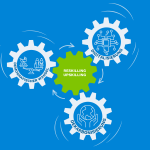The Digital Twin in practice
3 competitive advantages of using the asset administration shell
Digital transformation is all about making data usable. However, this is easier said than done, as data usually comes from different sources, has unknown formats, and often has to be processed in large quantities. This poses a challenge, especially for industrial digitalization.
The complexity of data can be reduced with the help of the Digital Twin. But what exactly is behind this abstract-looking term? In his podcast Digital4Leaders, Jan Veira talked about this with both Dr. Birgit Boss and Dr. Mathias Bölke. Find out in this article how companies can use the Digital Twin in practice.
What is a Digital Twin?
In concrete terms, the Digital Twin of a product or asset (e.g., a machine in manufacturing) is based on the Asset Administration Shell (AAS). It records and documents data over the entire life cycle of the product in a standardized data model. This not only enables cross-manufacturer data exchange and cross-production collaboration between different companies, it also offers new possibilities in process automation when it comes to designing processes efficiently, safely and in a way that saves resources.
The asset administration shell…
- implements the Digital Twin for Industry 4.0.
- provides structure for information about assets.
- has defined information groups ("sub-models"), interfaces ("API") and principles ("semantics").
- standardizes the structure of Digital Twins.
- is a prerequisite for the path to the Smart Factory, the basis for Industry 4.0.
- was developed by IDTA as an agile standard for implementing the Digital Twin.
3 Competitive Advantages through the Digital Twin Standard
In the podcast, Dr. Mathias Bölke drew attention to three areas in which the Digital Twin can be used to advantage: asset compatibility, smart factory and sustainability:
In all these areas, it's about using the Digital Twin to aggregate and make available all the relevant data for an asset. This saves time and money, even in the trial-and-error phase, which results in considerable advantages for the manufacturers of the aggregates and the machine builders, as well as for the integrators.
But how can the asset administration shell be concretely used in these areas? In the following, you can find some practical examples that show how to draw competitive advantages from the Digital Twin.
1. Asset compatibility and interoperability
The asset administration shell is used to increase asset interoperability, i.e., the ability to interoperate with other assets and systems, it also makes it possible to exchange data between assets from different manufacturers. For manufacturers, suppliers, customers and factories, the standardized representation of data simplifies cooperation.
- The use case Control Cabinet with Product Carbon Footprint – Management of the Greenhouse Gas Balance is about determining the carbon footprint of manufactured products (PCF) and making this information available across a product's entire supply chain.
- Here, the asset administration shell creates the possibility to share and retrieve carbon footprint information in an automated and low-effort way - across different data ecosystems.
- This achieves interoperability of different data ecosystems and PCF calculation methods.
2. Smart manufacturing
The Digital Twin connects physical industrial products with the digital world. Therefore, it plays an important role in so-called smart manufacturing when it comes to process improvements and new value creation potential in industrial production.
- In the Digital Nameplate use case, product information such as origin, properties, and capabilities of the product is digitally mapped.
- The digital nameplate contains documentation, safety instructions in the local language, and extended product services.
- It can be updated at any time, which means that maintenance work involving changes to the product or software updates can be carried out without any problems.
- It also avoids the need for large volumes of analog documentation, thus conserving resources.
- The structure of the asset administration shell also allows modular expansion and thus greater scaling possibilities, all the way to a holistic digital product passport.
3. Global impact und standardization
Standardization makes it possible to save not only costs and manpower, but also resources, and thus to position oneself at the forefront of sustainability. Predictive maintenance, for example, means that maintenance is only carried out when it is really necessary and defective equipment can be replaced quickly and with little engineering effort. Transparency about energy consumption can also be created using the Digital Twin standard.
- In the Collaborative Condition Monitoring (CCM) use case, operating data is collected, shared and used multilaterally. This makes it possible to optimize the reliability and service life of machines and their components.
- The network in which the data is shared consists of component manufacturers, machine manufacturers and machine operators.
- Machines typically contain different components from different manufacturers. This presents production with the challenge of finding the components in operation on the Industrial Internet of Things (IIoT) to easily and securely access their generated data.
- The management shell reduces these efforts: As a standardized Industry 4.0 interface it enables simple data integration (e.g., via REST API), and as a standardized Industry 4.0 information model it offers the possibility of semantically annotating operating data, i.e., making it machine-interpretable.
Together with the IDTA (Industrial Digital Twin Association) we offer two blended learning training programs on the Digital Twin. The first training provides you with a basic understanding of the Digital Twin and the standard of the asset administration shell. In the implementation training that builds on the first training you will learn how to build and use a Digital Twin for your company and your specific use case.
The next Digital Twin Training starts soon




